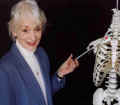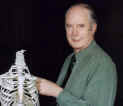 |
 |
 |
Helping You To Achieve ©™

![]()
Helping You To Achieve ©™
|
|
Mark with a surface marking pen the projected course of the Sciatic Nerve from the Greater Sciatic foramen under the Gluteus Maximus to the apex of the Popliteal fossa on a model in the Anatomical position with a time limit of two minutes.
Objective No 157 - Criteria to be demonstrated. 1. Surface mark the Posterior Superior Iliac Spine. (Objective No 86) 2. Surface mark the position of the Ischial Tuberosity (Objective No 88) 3. Surface mark the position of the Greater Trochanter (Objective No 87) 4. Draw a vertical line connecting the Posterior Superior Iliac Spine and the Ischial Tuberosity. 5. Mark the mid-point of the vertical line and a point just lateral to the mid-point. 6. Draw a horizontal line from the Ischial Tuberosity to the Greater Trochanter. 7. Mark the mid-point of the horizontal line and a point just medial to the mid-point. 8. Join lateral point in step 5 to the medial point in step 7 with a line convex gently towards the lateral aspect. 9. Continue to draw the line in a vertical direction down towards the apex of the Popliteal Fossa. 10. The line drawn represents the course of the Sciatic nerve which splits into the Common Peroneal and Tibial nerve during its descent to the Popliteal Fossa.
|
Service ProvisionBronze. Students may take up a ,'Free start up ' package consisting of 100 of the behavioural objectives and criteria based on common questions asked in Living Anatomy. These are available free of charge on this Website. Silver. Students may buy a copy of the book "Surface and Living Anatomy" (ISBN: 0 7234 3261 9) which comes with a CD Rom (Windows PC format) containing 230 objectives which includes the 100 behavioural objectives contained in the Bronze Service. Gold "Helping you to Achieve" Contact Information
|